|
Goals
The
purpose of this visit was to introduce Chabo, a male
chimpanzee on loan from Japan, to two females (Nannan
and Yaya) for breeding purposes.
Chimpanzees
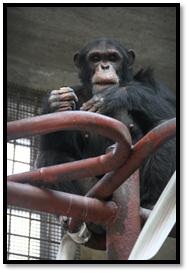 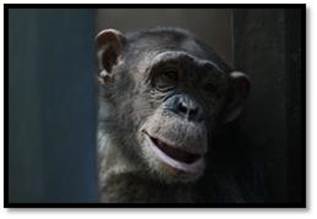 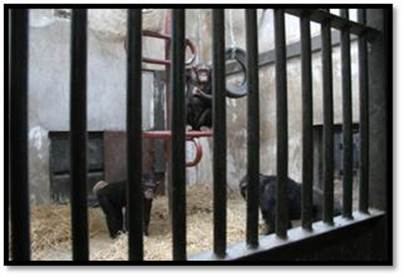
Chabo,
Nannan and Yaya (sorry, not
portrait picture was available of Yaya)
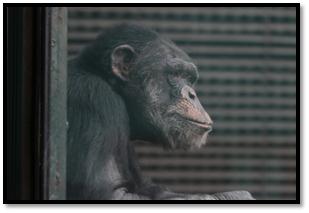 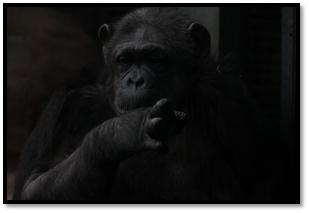
Feifei
and Moli
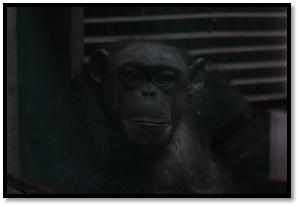 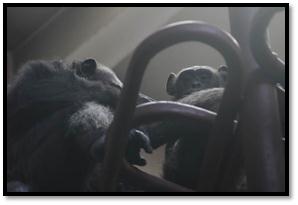
Anitte
and Anok (Laoer)
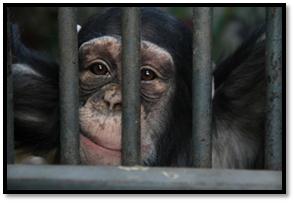 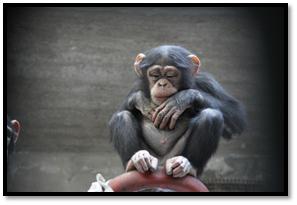
Qiqi
and Sisi
|
No. 1
Nannan F 12
Yaya
F 15
|
No. 2
Chabo
M unknown
|
No. 3
Place
for intro
|
3/a
|
No. 4
Feifei M 28
Moli
F 30
|
|
3/b
|
|
Corridor
|
No. 5
Empty
|
|
No. 6
Anok F 28
Annite
F 28
|
|
No. 9
Occupied
by an orangutan
|
No. 8
Empty
|
No. 7
Qiqi M 4
Sisi
F 4
|
|
Introduction
Feifei
was the group’s original alpha male. Due to siring
many offspring (Nannan, Yaya, Qiqi, Sisi), Chabo was
brought in to start a new bloodline; however, during
prior introductions, there seemed to be elevated
aggression between the two adult females and the new,
younger male. They teamed up against him and often
chased him away, not willing to breed.
The
zoo also had two infant chimpanzees, Qiqi and Sisi,
separated from their parents and being hand-reared due
to their mothers lacking milk. In the opinion of the
staff, reintroduction was not favorable, because one of
the females killed a baby several years ago.
These
circumstances altered the original plan. After careful
consideration, it was decided that first Chabo would be
introduced to the infants. If the adult females were
hostile towards him, it would have given him a good
chance to build a buddy system and the three of them
could protect each other. The infants were transported
from the end of the building (No. 7) into an empty
introduction cage (No. 3) and housed inside the two
smaller cages within his enclosure (No. 3 and b). These
cages were made of bars so the infants could see
everything and have partial tactile access to the
adults. Chabo was accessed to cages No. 2 and No. 3.
The
introduction went well, but needed to slow down for
several reasons. Since the infants grew up without
parents, they were lacking social skills. Qiqi, the
young male was braver, initiating a lot of contact, but
he did not know how to behave in the presence of a big
male. He did not show proper submissive behaviors.
Although Chabo
received a lot of quasi-aggressive behaviors from him, being “teased”
and “bothered” by him (usually Qiqi poking him,
throwing substrate at him, hitting him from behind,
etc.), he tolerated Qigi’s behaviors well and remained
relaxed. Sisi on the other hand, was very frightened of
Chabo, vocalized a lot or sat on the floor hugging straw
and rocking. Obviously all three of them needed some
time to adjust and bond. They were together for half
days every day and separated at night.
 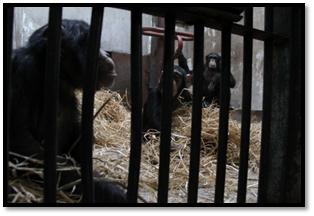
In
the meantime, in the mornings Chabo was introduced by
dyadic introductions to the females. Separating the two
females prevented their teamwork and extra aggression.
During the introductions, the two infants were locked
inside their cages and could follow developments.
The
introductions worked well and Chabo bred with both
females several times separately. Once they established
a good relationship as couples, the three of them were
put together. They have been getting along well ever
since.
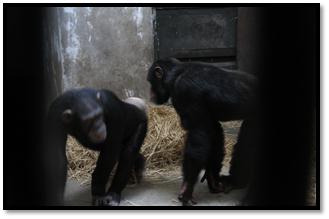 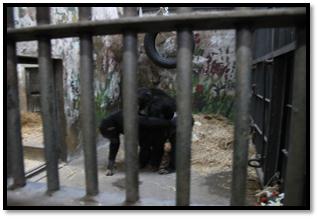
During
the morning, Chabo was with the two females. In the
afternoon, he was with the two infants, and then
separated at night. The females had the mornings to
interact with Qiqi and Sisi, while Chabo technically
spent the entire day with them until the keeper went
home.
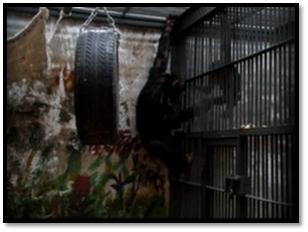 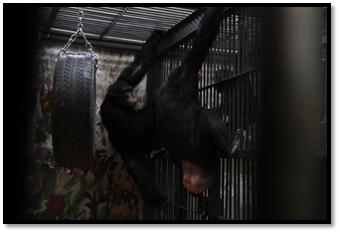
Unfortunately,
after I left on December 16, the chimpanzees got into a
small fight and Chabo bit Qiqi. It happened during
shifting Chabo from the two adult females to the
infants. When the shifting gate opened, Chabo ran
towards Qiqi, bit his right eye and bit his right wrist
and shoulder. Sisi was crying and rocking during it.
Currently the two babies are separated into their
smaller cages and Chabo is together with the two
females. The infants’ two small cages were furnished
after the separation.
Suggestions: It is very difficult to give an educated suggestion
when one did not see the events happen; however, in
theory; the infants should not be separated from Chabo
just because they had a fight. Chimpanzees will fight
all the time and will receive small wounds periodically,
especially during circumstances when animals lack social
skills. None of these animals know how to behave
properly. In any case, there are several things that can
be tried:
·
Chabo
can be put together with the infants again and see how
they do after their first fight. Unless Chabo tried to
kill Qiqi (which he clearly did not, otherwise he would
have) a reintroduction should take place. Chabo was
probably reprimanding Qiqi for something improper he did
(unintentionally), although that is only speculation.
·
Chabo
can be put with one of the females and the infants can
be introduced to the other female. Hopefully they like
each other and bond. If they do, leave them together for
a while and then the second adult female can be
introduced to this group of three. If the first adult
female did not like the infants that much, then the
other female could be introduced instead. One of the
females must like (hopefully) the infants. Once one of
the adult females bonded with the infants, she will
protect them from Chabo or from the other female, if
necessary.
·
If
nobody will take the responsibility for further
introductions, the infants should be moved into the two
adult females’ large cage (No. 1). This cage has a
small window with the adjacent cage (No. 2) through
which the animals can still partially interact. Chabo
and the females can have (No. 2) and (No. 3) together.
·
Within
a few months, the chimpanzees need to be introduced into
a larger group. They are infants and they need surrogate
parents.
Substrate
and furniture
The
cages were lacking flaxible furniure and substrate.
Prior to the introduction, hammocks and tires were hung
and all cages were filled with straw to cover the
concrete.
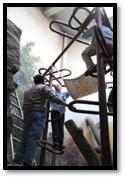 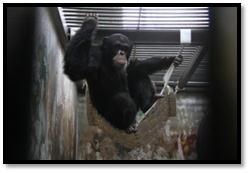 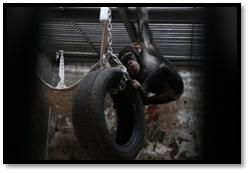
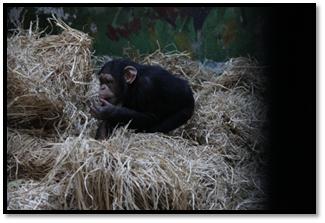 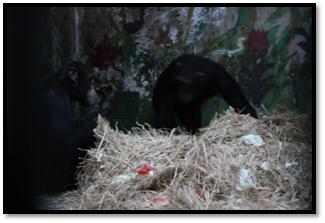
Suggestions:
Begin keeping animals off of unyielding surfaces (brick,
concrete, etc.). The use of appropriate substrate
(inside – paper products, hay or straw, etc.; outside
– nonflammable materials such as grass, sand, soil,
mulch, fresh browse, etc.) will make a significant
difference not only in the animals’ mental and
physical health, but also in the improvement of the
exhibit aesthetics. Using substrate will reduce cleaning
time and water consumption, as well. Soaking, scrubbing
and hosing dry waste takes much longer than spot
cleaning substrate due to the substrate’s ability to
absorb urine and cover fecal matter. Reducing hosing and
partially covering surface with substrate will overcome
any of these obstacles and provide animals with a soft
surface. In China, paper products are toxic, but
pet-safe, eco-friendly products (bags, wrapping papers,
boxes, burlap bags, etc.) are available online. Please
review samples:
It
would also be advantageous to build double sliding
doors (one being solid and the other one bars and
mesh) to make future introductions easier. The night
houses and the exhibit can be connected with a “Round
Robin” system, allowing animals to move about in
circular ways and not just a linear fashion. This system
can be used for all other species as well and would help
with introductions or with shifting animals more easily
and quickly.
Winter Care
Chimpanzees
can be allowed outside for limited time during the
winter; however, they need to have access to inside heat
and provided with extra blankets. Some institutions keep
to a temperature guideline and will only let their
chimpanzees out if the temperature reaches 10-13 C,
while others, such as Chimpanzee Sanctuary Northwest,
USA, allow the chimpanzees to make their own decision.
It is important to remember to provide chimpanzees the
opportunity to seek warmth if allowed outdoor access
during cold weather, and there might be a temperature so
low that outdoor access is inappropriate.
The only time they don't allow them outside is when
heavy, wet snow reduces the voltage on their electric
fence.
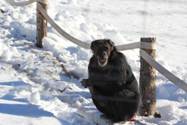 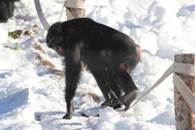 
csnw chimpanzee snow
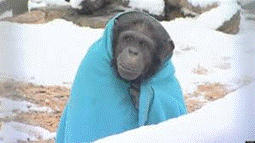
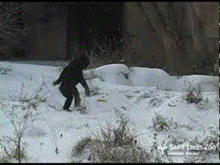
Wales
Ape and Monkey Sanctuary, U.K.
Saint Louis
Zoo, USA
See-through
curtains made from heavy-duty plastic strips can be hung
inside the night houses to keep the animals warm.
Management must
take
into consideration the type of enclosure, the animals’
behavior and characteristics, the materials used, if it
would prevent the animals from exiting or entering the
enclosure, etc.
Suggestions:
The method used by the Chester Zoo, England is simple. Strips
of thick, clear ARCO PVC is cut to the length of the
slide and the holes are drilled in the PVC. A
strong, thick metal plate, which has the same amount of
holes drilled in it, is lined up and bolted onto the
wall. This makes it a lot easier to take off and
replace the broken or torn PVC strips.
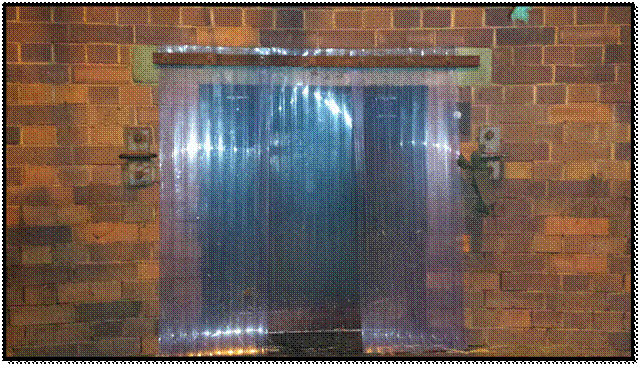
General
Propositions
Browse
Suggestions:
Browse should be provided at least every 2 – 3 days,
but if possible, every day for the animals. The zoo
would benefit by planting edible trees, bushes
and even crops inside and outside of exhibits and along
visitor pathways. The bushes can provide future browsing
materials for growing collection demands. Whether cut by
staff or available by natural damage, fallen vegetation
of approved browse plants can be used rather than
wasted.
Automatic
Watering System
Beijing
has a good automatic watering system. They should share
the knowledge with other Chinese zoos.
General
Information
The
majority of time was spent with the chimpanzee
integrations; therefore, there were not many
opportunities to look around and address other needs.
However, it seemed like most animals were locked inside
during winter time. Some of these animals may not need
to be held inside for several months. Since all of them
could not be addressed onsite, over
a hundred husbandry manuals, Species Survival
Plan manuals, studbook information, books in downloaded
formats,
Association of Zoos and Aquariums and
African Association of Zoos and Aquaria
accreditation standards and articles, PowerPoint
presentations, etc. were provided to offer correct
information and continue with improvements.
Elephant
Care
A
short visit was made to the elephant area. Elephants
were locked inside traditional concrete barns with no
enrichment. The Phoenix Zoo’s Elephant Enrichment
PowerPoint presentation was shown to the
elephant staff describing how this enrichment
program helped the Phoenix Zoo to have mentally
healthier elephants. It also addressed some of the foot
work helping to keep Phoenix Zoo elephants’ feet in
better shape and preventing all suffering that wet
concrete can cause.
The
elephant staff has already made some very important
changes! Not only are the animals enjoying new mesh and
barrel puzzle feeders and logs, but also by having these
new enrichment opportunities, a new and invaluable
educational opportunity is being provided to all
visitors.
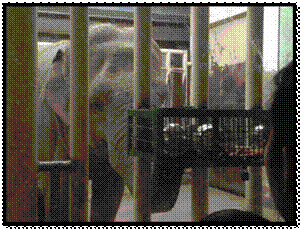 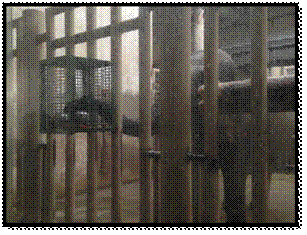
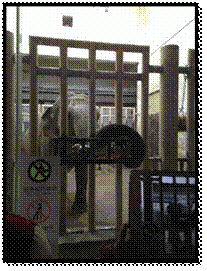 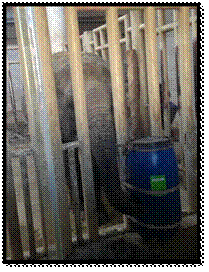
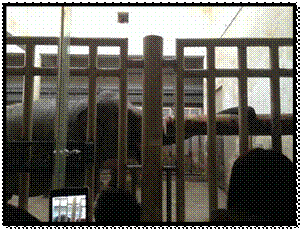 
I
would like to thank Animals Asia Foundation for funding
and organizing this trip and establishing such a
wonderful, working relationship between the Jane Goodall
Institute, the Phoenix Zoo and the Beijing Zoo.
Hilda
Tresz
Behavioral
Enrichment & International Animal Welfare
Coordinator
Mentor,
The Jane Goodall Institute
Phoenix
Zoo | Arizona Center for Nature Conservation
455
N. Galvin Parkway | Phoenix, AZ 85008
p
602.286.3800 x 7120 | d 602.286.3820
htresz@phoenixzoo.org
| phoenixzoo.org
|
































